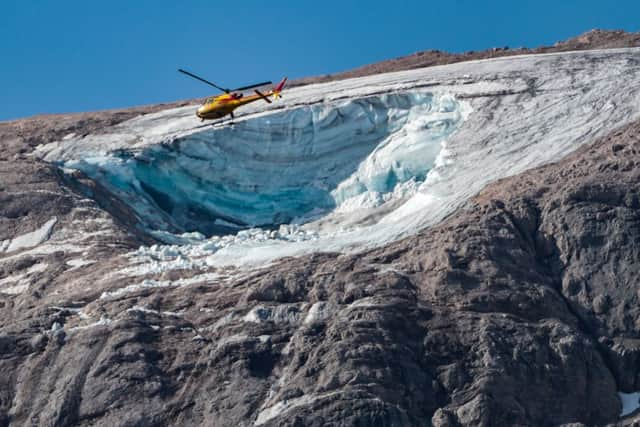Marmolada glacier collapse: what happened in Italy as six killed in Italian Alps, and where are the Dolomites?
and live on Freeview channel 276
Some 17 people remain unaccounted for a day after a huge chunk of an Alpine glacier broke off and crashed into hikers in northern Italy, officials have said.
At least six people died and nine were injured as the avalanche of ice, snow and large rocks thundered down the slope of the mountain topped by the Marmolada glacier on Sunday (3 July) afternoon.
Here is everything you need to know about it.
Advertisement
Hide AdAdvertisement
Hide AdWhat happened?
What caused a pinnacle of the glacier to break off and thunder down the slope at a speed estimated by experts at nearly 200mph was not immediately known.
But the heatwave gripping Italy since May, bringing temperatures unusually high for the start of summer even up in the normally cooler Alps, was being cited as a likely factor.
Jacopo Gabrieli, a polar sciences researcher at Italy’s state-run CNR research centre, noted that the long heatwave, spanning May and June, was the hottest in northern Italy in that period for nearly 20 years.
“It’s absolutely an anomaly,” Gabrieli said in an interview on Italian state TV.
Advertisement
Hide AdAdvertisement
Hide AdLike other experts, he said it would have been impossible to predict when or if a serac – a pinnacle from a glacier’s overhang – could break off, as it did on Sunday.
Alpine rescuers on Sunday noted that late last week, the temperature on the 3,300-metre high peak had topped 10C, far higher than usual.
Operators of rustic shelters along the mountainside said temperatures at the 2,000-metre level recently reached 24C, unheard-of heat in a place where visitors go in summer to keep cool.


Who are the victims?
The nationalities of the known dead have not been disclosed, and conditions were too dangerous on Monday (4 July) morning for rescue crews with dogs to resume the search for those missing or to bring down the bodies.
Advertisement
Hide AdAdvertisement
Hide AdThe bodies will be brought to an ice skating rink in the resort town of Canazei in the Dolomite mountain range for identification.
Trento prosecutor Sandro Raimondi said that 17 hikers were believed to be missing, the Italian news agency LaPresse reported.
Raimondi was quoted as saying two of the nine injured are Germans. Of the injured patients, one of those in intensive care has yet to be identified.
Who is still missing?
16 vehicles remain unclaimed in the area’s car park, and authorities sought to track down occupants through licence plates.
Advertisement
Hide AdAdvertisement
Hide AdIt is unclear how many of the cars might have belonged to the already identified victims or to the injured, all of whom were flown by helicopters on Sunday to hospitals.
Rescuers said conditions downslope from the glacier, which has been melting for decades, were still too unstable to send back teams of people and dogs to dig into tons of debris.
Drones are being used to look for any of the missing.
Where are the Dolomites?
The glacier, in the Marmolada range, is the largest in the Dolomite mountains in north-eastern Italy. People ski on it in the winter.
But the glacier has been rapidly melting away over the past decades, with much of its volume gone.
Advertisement
Hide AdAdvertisement
Hide AdExperts at Italy’s state-run CNR research centre, which has a polar sciences institute, estimated a couple of years ago that the glacier will not exist within 25-30 years.
The Mediterranean basin, which includes southern European countries such as Italy, has been identified by UN experts as a “climate change hot spot”, likely to suffer heatwaves and water shortages, among other consequences.
Comment Guidelines
National World encourages reader discussion on our stories. User feedback, insights and back-and-forth exchanges add a rich layer of context to reporting. Please review our Community Guidelines before commenting.
